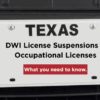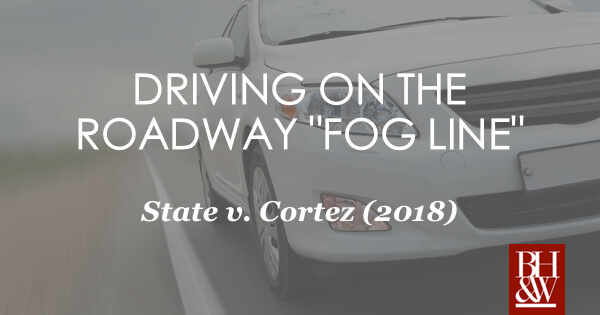
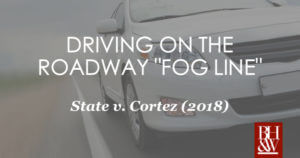 State v. Cortez (Tex. Crim. App. 2018)
State v. Cortez (Tex. Crim. App. 2018)
Jose Cortez was stopped because a Texas State Trooper allegedly observed him driving on an “improved shoulder” in violation of Texas Transportation Code § 545.058. The officer testified that Cortez touched the white “fog” line of the road and crossed it twice. During the ensuing stop, the trooper searched Cortez’s vehicle and found drugs. Cortez moved to suppress the stop (and the search) arguing that the officer lacked probable cause to initiate the stop.
What is Driving on the Improved Shoulder?
The Texas Transportation Code also defines “improved shoulder” as a “paved shoulder” with the “shoulder” being the “portion of the highway that is:
- adjacent to the roadway;
- designed or ordinarily used for parking;
- distinguished from the roadway by different design, construction, or marking; and
- not intended for normal vehicular travel.”
The Texas Transportation Code §545.058 prohibits drivers from driving on the shoulder unless it is necessary and done safely, “but only:
- to stop, stand, or park;
- to accelerate before entering the main traveled lane of traffic;
- to decelerate before making a right turn;
- to pass another vehicle that is slowing or stopped on the main traveled portion of the highway, disabled, or preparing to make a left turn;
- to allow another vehicle traveling faster to pass;
- as permitted or required by an official traffic-control device; or
- to avoid a collision.”
Court Suppressed the Traffic Stop Because Driving on the Shoulder Did Not Violate Any Laws
In this case, the trial court determined, after careful review of dashcam footage and officer testimony, that Cortez did not appear to touch the fog line, and that even if he did, that was not a violation of the law. The courts also reasoned that if Cortez did cross the line, he was doing so to let the officer pass and to exit the highway, both reasons justified by the statute. The court of appeals affirmed the trial court’s suppression of the stop. The Texas Court of Criminal Appeals agreed and affirmed the lower court’s ruling.
What Does This Mean for Texas Drivers?
First, it is not illegal to touch the white line of the shoulder under Texas Transportation Code § 545.058. If you are pulled over for this, the courts have determined this is not a violation of the law and does not provide a reasonable basis for an officer to pull you over and search your vehicle.
Second, if you do cross the white line, that is not necessarily a violation. If one of the acceptable reasons above is present, then it is permissible to cross the shoulder line and the police will not have a reasonable basis for stopping you and should not stop you or search your vehicle.
Overall, you should pay close attention when you are driving. But the courts have acknowledged that it is nearly impossible to drive in a perfectly straight line. The police do not automatically have a reasonable basis to stop you if you cross the white line, and they have NO basis for stopping you if you merely touch it. However, as we have always said, if you are stopped, be polite, be courteous, and do not consent to any searches.
NOTE: Presiding Judge Keller dissented in this case and would hold that driving on the white fog line does constitute driving on the improved shoulder in violation of the transportation code.


 The Court of Criminal Appeals recently handed down a case regarding a police officer’s findings of reasonable suspicion and probable cause. The issue was whether an officer had probable cause to arrest a customer for theft from a store before she actually exited the store and when she claimed, after being confronted by the officer, that she was going to pay for the items shad had placed in her purse.
The Court of Criminal Appeals recently handed down a case regarding a police officer’s findings of reasonable suspicion and probable cause. The issue was whether an officer had probable cause to arrest a customer for theft from a store before she actually exited the store and when she claimed, after being confronted by the officer, that she was going to pay for the items shad had placed in her purse.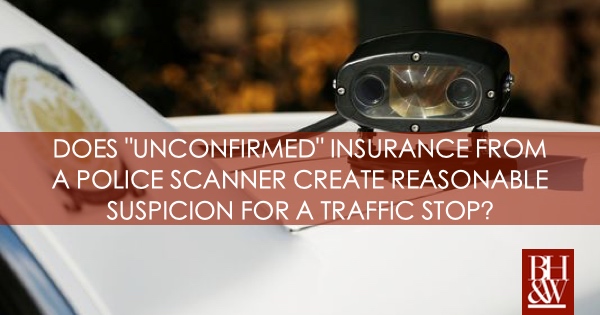
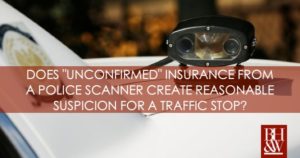 While conducting surveillance on an illegal immigration investigation, Homeland Security agents saw a vehicle leave a residence suspected of harboring undocumented immigrants. The agents notified local police officers to be-on-the-lookout for the vehicle. While on patrol, an officer began to follow the defendant’s vehicle because it matched the description of the vehicle from Homeland Security. While following the vehicle, the local officer entered its license plate number into a computer database designed to return vehicle information such as insurance status. The computer indicated the insurance status was “unconfirmed.” Based on his experience using this system, the officer reasoned that the vehicle was most likely uninsured, which is, of course, a violation of Texas law. The officer then conducted a traffic stop of the vehicle and learned that the defendant was in the United States illegally. The officer issued the defendant citations for violating the insurance requirement and driving without a license while he waited for the Homeland Security agents to arrive.
While conducting surveillance on an illegal immigration investigation, Homeland Security agents saw a vehicle leave a residence suspected of harboring undocumented immigrants. The agents notified local police officers to be-on-the-lookout for the vehicle. While on patrol, an officer began to follow the defendant’s vehicle because it matched the description of the vehicle from Homeland Security. While following the vehicle, the local officer entered its license plate number into a computer database designed to return vehicle information such as insurance status. The computer indicated the insurance status was “unconfirmed.” Based on his experience using this system, the officer reasoned that the vehicle was most likely uninsured, which is, of course, a violation of Texas law. The officer then conducted a traffic stop of the vehicle and learned that the defendant was in the United States illegally. The officer issued the defendant citations for violating the insurance requirement and driving without a license while he waited for the Homeland Security agents to arrive.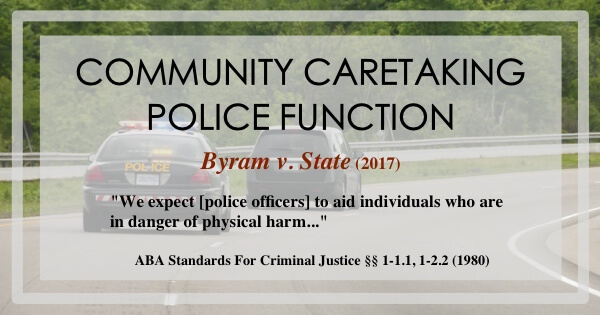
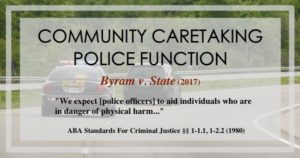 In November of 2015,
In November of 2015, 
 Furr v. State (Tex. Crim. App. 2016)
Furr v. State (Tex. Crim. App. 2016)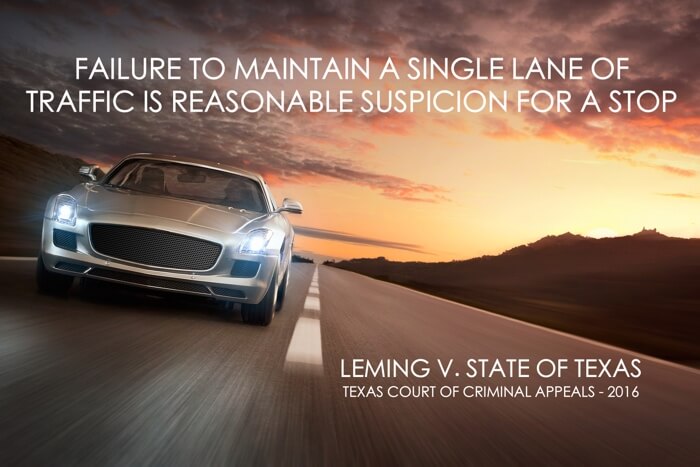
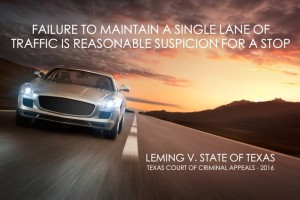 James Leming was convicted of DWI after erratic driving alarmed fellow motorists to call police. On January 20, 2012, a citizen filed a report of a “swerving Jeep” and Officer Manfred Gilow responded. As the dashboard camera confirmed, the Jeep traveled thirteen miles under the speed limit; Gilow followed the Jeep for several miles. Officer Gilow observed the Jeep, “drifting [within the] lane to the left [with] tires on the stripes… back to the right, almost hit[ting] the curb twice.”
James Leming was convicted of DWI after erratic driving alarmed fellow motorists to call police. On January 20, 2012, a citizen filed a report of a “swerving Jeep” and Officer Manfred Gilow responded. As the dashboard camera confirmed, the Jeep traveled thirteen miles under the speed limit; Gilow followed the Jeep for several miles. Officer Gilow observed the Jeep, “drifting [within the] lane to the left [with] tires on the stripes… back to the right, almost hit[ting] the curb twice.”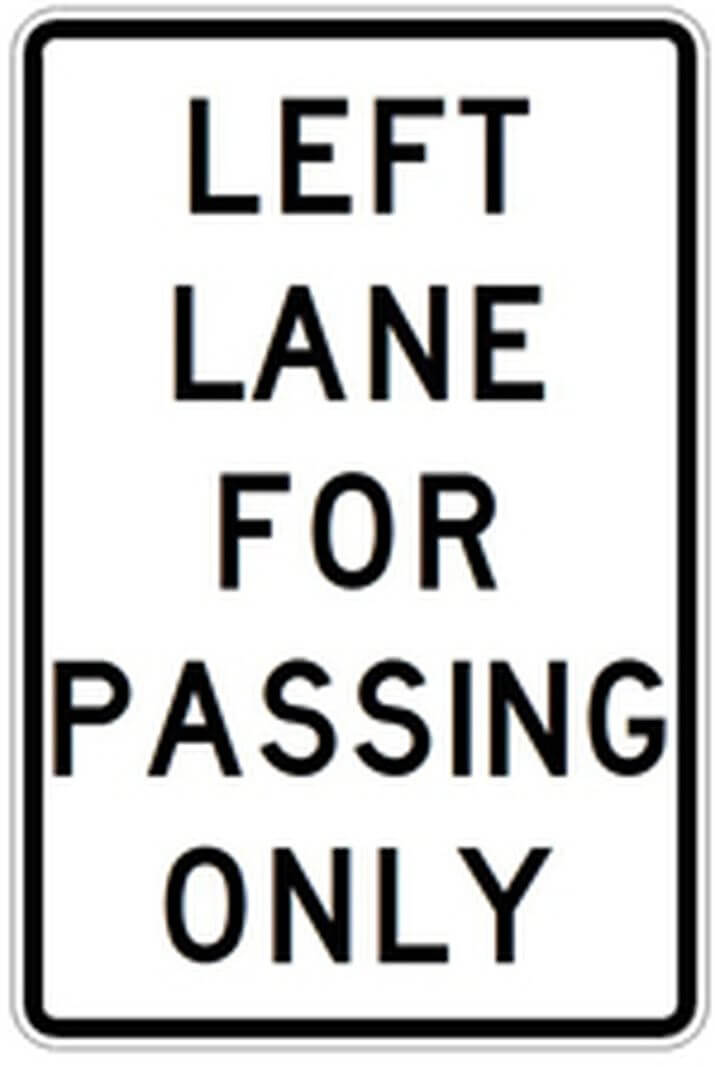
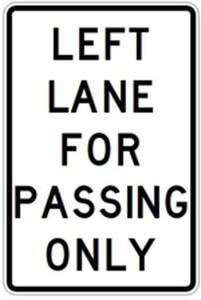
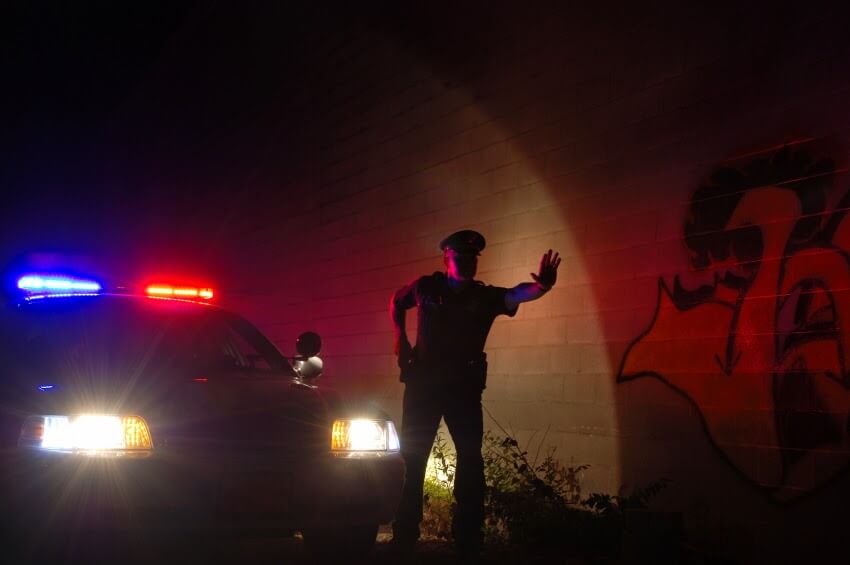
 State v. Johnson
State v. Johnson
 In many ways, Texas Court of Criminal Appeals also acts the State’s highest traffic court. What follows is a synopsis of
In many ways, Texas Court of Criminal Appeals also acts the State’s highest traffic court. What follows is a synopsis of 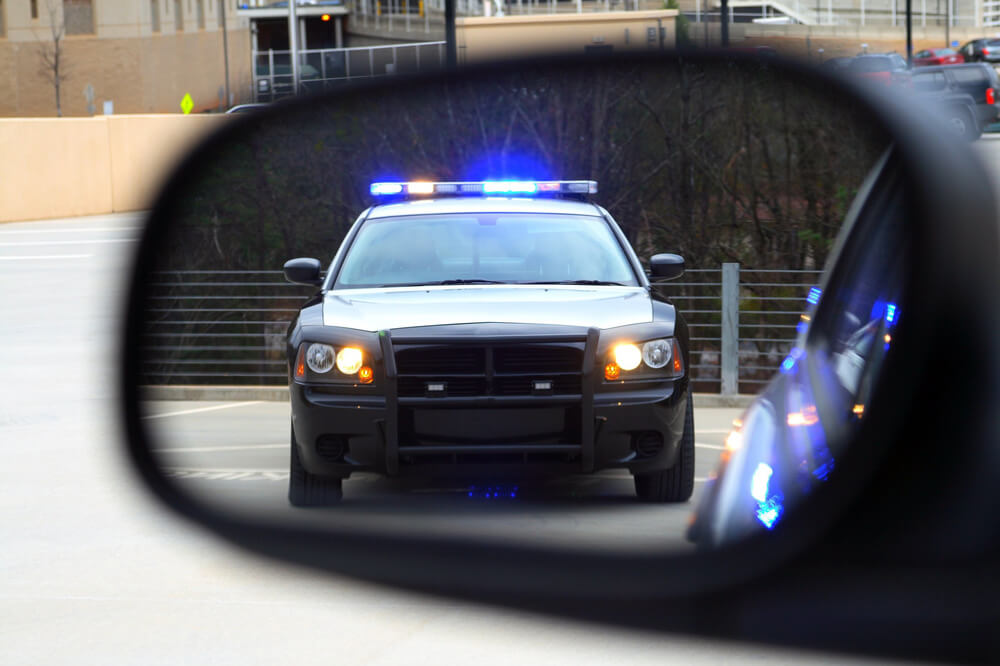
 You can’t believe anything he says. He tries to sound intelligent and reliable, but falls far short. Did you think I was writing about a political candidate? Nope. A police officer.
You can’t believe anything he says. He tries to sound intelligent and reliable, but falls far short. Did you think I was writing about a political candidate? Nope. A police officer.



